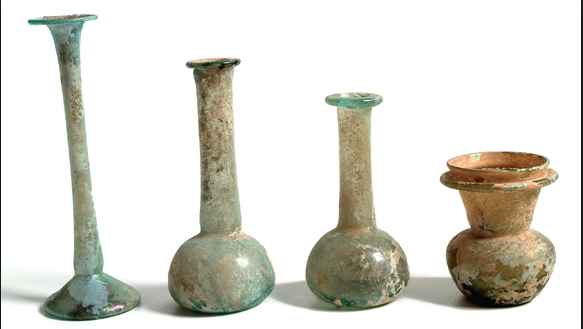Introduction
Imagine holding a small glass bottle once treasured by a Roman noblewoman over 2,000 years ago. Inside, it still carries faint traces of a fragrant oil that once scented baths, garments, and hair. This ancient Roman perfume bottle tells a story of artistry, trade, and daily life in one of history’s greatest empires. From the workshop where it was blown and shaped to the tomb where it lay undisturbed, this tiny vessel bridges past and present. Join us as we explore its origins, uses, archaeological discovery, and what it reveals about Roman culture.
Crafting the Perfume Bottle
Glassmaking in the Roman World
Romans mastered glassblowing by the 1st century BCE. Artisans heated sand and soda ash in furnaces until molten, then blew air through a metal tube to form a bubble. By skillfully turning, cutting, and reheating, they shaped delicate bottles like the one we find today.
Design and Decoration
Perfume bottles came in several shapes—tear-drop, cylindrical, and flat flasks called unguentaria. Most were small, just 5–7 cm tall, to hold precious oils. Common features included:
- Pinched Necks: For controlled pouring of a few drops.
- Bulbous Bodies: To store enough perfume for daily use.
- Applied Handles: Tiny loops to tie a cord or ribbon, preventing loss.
Some bottles bore colored trails or embedded dots as simple decoration. Luxurious versions featured gilded threads or cameo reliefs.
The Fragrant Contents: Roman Perfume
Ingredients and Origins
Roman perfumes blended exotic spices, flowers, and resins imported from across the empire:
- Frankincense and Myrrh: From Arabian deserts.
- Cinnamon and Cassia: From far-off Ceylon (modern Sri Lanka).
- Rose and Violet Oils: Cultivated in Mediterranean gardens.
- Lavender and Juniper: Local herbs added depth.
Perfumers macerated plants and resins in olive or almond oil to extract scent, then filtered and sometimes distilled the mixture.
Uses in Daily Life
Perfumes played a role in Roman hygiene and ritual:
- Bathing: A few drops of scented oil added to bathwater or rubbed onto the skin after bathing.
- Cosmetics: Mixed with makeup or used to freshen hair and clothes.
- Religious Offerings: Sprinkled at temples to honor gods and goddesses.
- Funerary Rites: Used to anoint the dead and mask the odor of decay.
These fragrant oils were not mere luxury—they helped Romans cope with hot climates and distance from running water.
Archaeological Discovery
Excavation Site
Our bottle was unearthed in the ancient city of Pompeii, buried beneath volcanic ash after the eruption of Mount Vesuvius in 79 CE. Archaeologists discovered it in a wealthy home’s bathroom, alongside marble bath basins and a mosaic-decorated floor.
Context and Dating
Because it lay undisturbed since the disaster, carbon dating of wooden oil stoppers and ceramic fragments around the bottle confirmed its mid-1st century CE origin. The fine Pompeian glass style and a small maker’s mark on the base further established its date and workshop region.
The Bottle’s Journey to Modern Times
Early Finds and Collecting
When Pompeii reopened to explorers in the 18th century, glass and pottery became prized curiosities among Grand Tourists. Many bottles were sold to collectors or displayed in early museums. Our bottle survived intact in a private collection before being donated to a national museum in the 1920s.
Conservation Challenges
Glass long buried can suffer from “glass disease”—a condition where moisture reacts with alkali in the glass, causing iridescent crusts. Conservators cleaned the surface with gentle chemical baths, stabilized cracks with resin, and sealed it in a controlled-humidity case to prevent further decay.
What This Bottle Reveals About Roman Culture
Trade Networks and Economy
The diverse ingredients in Roman perfume reflect vast trade routes. Spices sailed from India, resins traveled from Arabia, and flowers were grown locally. The high value placed on rare scents shows how trade shaped Roman wealth and taste.
Social Status and Luxury
Only the wealthy could afford imported perfume. Ownership of a fine glass bottle signified status. Artwork from the period depicts elegant women and men dabbing scented oils after public baths, highlighting perfume’s role in elite identity.
Daily Hygiene and Beliefs
Romans valued cleanliness and scent as part of personal and communal life. Public bathhouses were centers of social activity. Perfume oils not only masked odors but also carried symbolic meanings—frankincense for purity in religious rituals, myrrh for mourning in funerary rites.
Related Finds and Comparisons
Unguentaria Across the Empire
Similar unguentaria appear in Roman sites from Britain to North Africa. In Pompeii, dozens of shapes have been cataloged, but only a fraction were as finely made as ours.
Earlier Greek and Egyptian Bottles
Perfume storage dates back to ancient Egypt (c. 1500 BCE) and Greece (c. 500 BCE). Egyptian alabaster jars often held unguents for embalming, while Greek terracotta lekythoi carried scented oils. Roman glass bottles reflect technological advances and changing tastes over centuries.
Studying the Scents: Residue Analysis
Modern science can extract surviving aroma compounds from residue inside ancient bottles. Gas chromatography–mass spectrometry (GC-MS) has identified traces of opoponax, a resin noted in Pliny’s Natural History, confirming historical recipes. This chemical verification links literary references to physical artifacts.
Integrating History and Education
Museum Displays
Museums use interactive exhibits to let visitors handle replica bottles and smell re-created Roman perfumes. Tactile labels and video presentations bring the story to life for students and families.
Academic Research
Historians and archaeologists publish findings on perfume trade routes, production methods, and social contexts. Interdisciplinary studies combine botany, chemistry, and art history to paint a full picture.
Conclusion
The journey of this ancient Roman perfume bottle spans millennia: from skilled glassblowers and perfumers in 1st century CE Rome, through volcanic burial, to modern archaeologists and conservators preserving its fragile beauty. More than a pretty vessel, it reveals the commerce, culture, and customs of a world both distant and familiar. As science peels back layers of residue, we recreate the scents that filled Roman baths and temples, connecting us to everyday lives under empire. Next time you catch a whiff of lavender or rose oil, remember: you’re inhaling history itself—a legacy bottled in glass.










